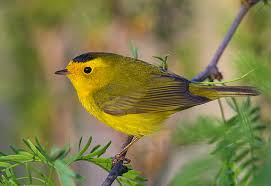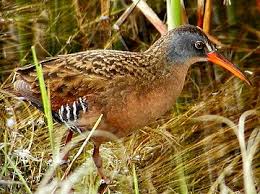
We spent a week in the mountains, with Long Lake as home base, birding various habitats and hiking conditions. The weather was very cool, with showers and thunderstorms almost every day, but the mornings were dry with some sunshine. I don't believe the temperature ever got above 74 degrees, with one night dipping to the low 40s. Blackflies were gone, replaced by flies and lots of mosquitos, but we've found a very effective repellent, so it was really a non-issue.
We arrived on Saturday the 11th, and on the trip north made a westward detour towards Moose River Plains Recreational Area, getting as far as the trailhead to Wakely Mountain before turning around. At Wakely Pond, on the north side of Moose River Rd., we saw a Common Loon diving out on the pond. A Ruby-throated Hummingbird was atop the thicket across the road, along with an American Redstart. The bugs were at their worst here, so we beat a hasty retreat to the rental vehicle and headed to the cottage.
On Sunday the 12th, the William C. Whitney Wilderness Area northwest of Long Lake was the destination. At our first stop, Little Tupper Lake, the parking area and adjacent access road were really hopping. It was tough to stay on any one bird for an identification, as this was an area with mostly tall deciduous trees, with some spruce and pine, and the birds were well concealed and higher up. We came away having seen a Blue-headed Vireo, heard several Black-throated Green Warblers, and many White-throated Sparrows, whose song became a common background sound this week, like Song Sparrow is around the Capital District area.
The former site of the Sabattis Railroad Station at the end of Sabattis Rd. was the parking area for our next stop, the railroad tracks leading northeastward from there; do not go the other way, as the surrounding area is private land, as is the road leading into the Hiawatha Scout Camp. There is a bog about a quarter-mile up the tracks (picture), and the habitat becomes boreal. This is a terrific avenue to view birds, as there is lower growth along much of the way, with the forest edge back aways, providing plenty of opening for perching birds. Chestnut-sided Warbler was common here, and we heard Black-throated Green again; the best sighting was a first for me, a Nashville Warbler, seen singing in the midstory of the trees. Other birds seen and heard were Gray Catbird, Northern Flicker, Wood Thrush, Cedar Waxwing and quite a few White-throated Sparrows. On the way out, a flock of six Purple Finches chattered their way across the road; this is the first time I've seen them where they looked like they were "dipped in raspberry juice."
Our final stop was a bog on the north side of Sabattis Circle Rd.; it was approaching noontime and activity had quieted down some, but I still managed two new birds: Common Raven and a Golden-crowned Kinglet, along with Red-breated Nuthatch and a singing Magnolia Warbler. To top off quite a fine morning deep in the woods, on the road back we came across two Ruffed Grouse, another bird I've never encountered before. They seemed quite approachable, as they stayed in the weeds along the roadside even as our vehicle passed and stopped. A great way to end our first full day of northern birding, with the best yet to come.






Tom, nice post. I am curious if you used the guidebook "Adirondack Birding" by John M.C. Peterson and Gary Lee, which has a chapter that includes all of your stops.
ReplyDeleteI did indeed, and planned to tout the book in the next installment; I had already linked to a bug repellent website, however, and I didn't want to seem too commercial with a first post in a new blog. The book is very good, maybe a bit optomistic, but the maps and directions are right on the mark. I understand you had a Black-backed Woodpecker on California Rd., is that correct? As hard as I tried, no such luck. Thanks for reading and don't be a stranger.
ReplyDelete